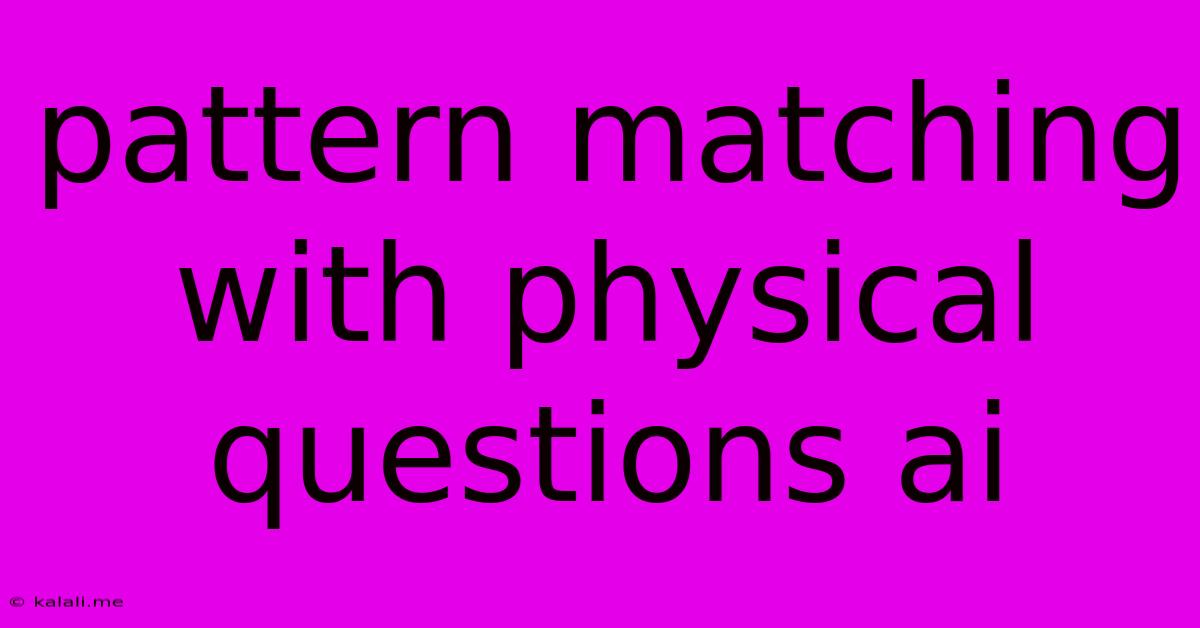Pattern Matching With Physical Questions Ai
Kalali
May 30, 2025 · 3 min read

Table of Contents
Pattern Matching with Physical Questions in AI: Unlocking Deeper Understanding
Meta Description: Explore the exciting intersection of AI and physical question answering. This article delves into pattern matching techniques used to enable AI to understand and respond accurately to questions about the physical world, encompassing image recognition, object detection, and reasoning.
The field of Artificial Intelligence (AI) is rapidly evolving, with significant advancements in natural language processing (NLP) and computer vision. One particularly challenging yet crucial area is enabling AI to understand and answer physical questions – questions requiring an understanding of the physical world, its objects, their properties, and their interactions. This involves more than just simple keyword matching; it necessitates sophisticated pattern matching techniques coupled with robust reasoning capabilities. This article will explore how pattern matching plays a vital role in achieving this ambitious goal.
What are Physical Questions?
Physical questions require the AI to interpret information beyond textual data. They demand an understanding of spatial relationships, object properties (size, color, shape, material), and actions. Examples include:
- "Is the red ball bigger than the blue cube?"
- "How many apples are on the table?"
- "What is the distance between the chair and the lamp?"
- "Which object is closer to the window?"
Pattern Matching Techniques for Physical Question Answering
Several pattern matching techniques are employed to help AI understand and respond to physical questions. These techniques often work in conjunction with other AI components such as:
-
Image Recognition and Object Detection: This is a crucial first step. The AI needs to accurately identify and locate objects within an image or video. Convolutional Neural Networks (CNNs) are frequently used for this purpose. Successful object detection generates structured data that describes the scene – the location, type, and attributes of each object. This structured data forms the basis for subsequent pattern matching.
-
Scene Graph Generation: Scene graphs represent the relationships between detected objects. They encode information like "object A is on top of object B," or "object C is to the left of object D." These graphs are crucial for answering complex physical questions involving spatial relationships.
-
Knowledge Graphs and Ontologies: External knowledge bases provide contextual information about objects and their properties. These knowledge graphs are invaluable for answering questions that require understanding object attributes beyond what's directly visible in an image. For example, knowing that apples are fruits.
-
Rule-Based Systems: These systems define explicit rules for handling specific patterns and relationships. For instance, a rule could state that if object A is larger than object B in the image and the knowledge base confirms that both are spheres, then "A is bigger than B" is true.
-
Template Matching: This technique involves defining predefined templates that represent specific question structures. When a question matches a template, a predefined process for extracting information and generating an answer is triggered.
Challenges and Future Directions
While significant progress has been made, challenges remain:
-
Ambiguity and Nuance in Language: Natural language is inherently ambiguous. AI needs to handle variations in phrasing and implied meanings effectively.
-
Complex Spatial Reasoning: Understanding complex spatial relationships and reasoning about them in three-dimensional space remains a considerable challenge.
-
Robustness to Noise and Occlusion: Real-world images are often noisy and may contain occluded objects. The AI system must be robust to these imperfections.
-
Generalization to Unseen Scenes: A key goal is to develop AI systems that can generalize their knowledge and reasoning capabilities to new and unseen scenes, not just those they've been trained on.
The future of physical question answering hinges on improvements in all these areas. Research is actively exploring the use of more advanced deep learning architectures, hybrid approaches combining rule-based systems with machine learning, and improved methods for representing and reasoning about spatial information. The development of more comprehensive and accurate knowledge graphs is also crucial.
By combining robust pattern matching with sophisticated reasoning capabilities, AI systems are steadily moving closer to a point where they can truly understand and respond meaningfully to complex physical questions, opening up numerous exciting possibilities in robotics, virtual reality, and other fields.
Latest Posts
Latest Posts
-
Am I On The Wrong Spot Meaning
May 31, 2025
-
Can Neon Tetras Eat Betta Food
May 31, 2025
-
Best Backer Board For Kitchen Backsplash
May 31, 2025
-
What Is A Three Way Bulb
May 31, 2025
-
How Do You Get Urine Smell Out Of Wood Floors
May 31, 2025
Related Post
Thank you for visiting our website which covers about Pattern Matching With Physical Questions Ai . We hope the information provided has been useful to you. Feel free to contact us if you have any questions or need further assistance. See you next time and don't miss to bookmark.